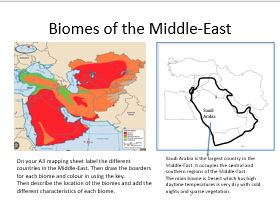



This engaging and adaptable lesson combines mapping skills and ecosystem knowledge, focusing on the biomes and animal adaptations of the Middle East. Designed to support the AQA GCSE Geography syllabus, students first complete a hands-on biome mapping task, colouring and annotating a clear outline map to show desert, forest, grassland, and mountain regions. The second half of the lesson explores animal adaptations to arid environments, using visual prompts, diagrams, and real-world examples like the camel and Arabian scorpion. Basic images are included and can be easily adapted or replaced to suit different classes, abilities or resource styles. Perfect for building geographic literacy, understanding climate challenges, and linking to Paper 1: Living with the Physical Environment.
Get this resource as part of a bundle and save up to 47%
A bundle is a package of resources grouped together to teach a particular topic, or a series of lessons, in one place.
The Middle-East unit plus booklet
Take your KS3 students on a journey through one of the most fascinating and misunderstood regions of the world with this engaging and fully resourced Middle East unit. This scheme of work introduces students to the physical geography, human landscapes, and contemporary challenges of the Middle East, including climate, conflict, resource management, and population dynamics. With case studies, enquiry-based tasks, and interactive activities—including map skills, data interpretation, and decision-making exercises—students develop a well-rounded and critical understanding of this diverse region. Perfect for deepening global awareness and building synoptic links across the geography curriculum.
The Middle-East KS3
Take your KS3 students on a journey through one of the most fascinating and misunderstood regions of the world with this engaging and fully resourced Middle East unit. This scheme of work introduces students to the physical geography, human landscapes, and contemporary challenges of the Middle East, including climate, conflict, resource management, and population dynamics. With case studies, enquiry-based tasks, and interactive activities—including map skills, data interpretation, and decision-making exercises—students develop a well-rounded and critical understanding of this diverse region. Perfect for deepening global awareness and building synoptic links across the geography curriculum.
Something went wrong, please try again later.
This resource hasn't been reviewed yet
To ensure quality for our reviews, only customers who have purchased this resource can review it
to let us know if it violates our terms and conditions.
Our customer service team will review your report and will be in touch.